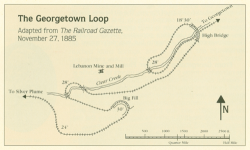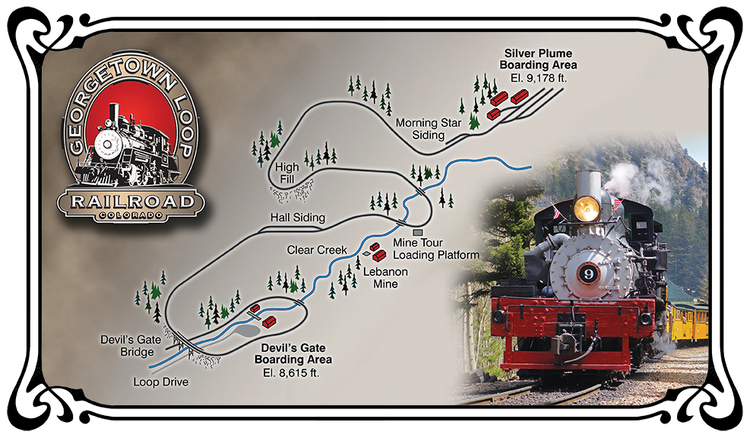
History of Georgetown Completed in 1884, this spectacular stretch of three-foot narrow gauge railroad was considered an engineering marvel for its time. The Georgetown Loop Railroad® was one of Colorado’s first visitor attractions with seven trains a day running out of Denver at the height of its popularity, the Georgetown Loop became Colorado’s scenic “must-see.” Guidebooks, pamphlets, and postcards help send the images of the steep canyons and mountain peaks finally accessible by train across the nation.
The Loop Then and Now

The Early Years
December 1872
The first railroad line up Clear Creek Canyon reaches Black Hawk. The construction, funded by bonds from Clear Creek and Gilpin Counties, was organized by William A.H. Loveland, a fifty-niner and proponent of the Colorado Central railroad.
1877
The railroad reaches Idaho Springs in June, thanks to financier Jay Gould who controlled the Union Pacific (UP) and supplied the necessary funds to complete both the route to Idaho Springs and the later route to Georgetown, completed in August 1877. The railroad makes access open for freight, ore, consumers and passengers to Georgetown. The Rocky Mountains are open for tourists.
1879
Georgetown becomes the “Silver Queen of Colorado” for only a short time that year when news of large silver strikes spread across the region from Leadville, one of the greatest strikes to date. Gould strives to have the Colorado Central be the first rail line to reach Leadville. The track to reach Leadville from Georgetown is an obstacle due to narrowing of the valley west of the city and an area where the average grade is over 6 percent (too steep for most trains). UP chief engineer, Jacob Blickensderfer, devises a system of curves and bridges, reducing the average grade to 3 percent. The plan includes three hairpin turns, four bridges and a 30-degree horseshoe curve from Georgetown to Silver Plume.
1884
The first trains arrive in Silver Plume. Another line, the Denver & Rio Grande (D&RG), is completed into Leadville from the south. Gould’s interest in pushing the Georgetown line over the mountains wanes. The Georgetown, Breckenridge and Leadville Railroad line ends permanently a few miles past Silver Plume.
1880s and into the early 1900s
The community and the Georgetown Loop become a tourist center for those who venture West to encounter the wild ruggedness and romance. Tourism in the West develops around railroad excursions. With seven trains a day running out of Denver at the height of its popularity, the Georgetown Loop is Colorado’s scenic “must see” and a deal at only $3 round-trip. Guidebooks, pamphlets and postcards help send the images of the steep canyons and mountain peaks accessible by train across the nation.
Early 1900s
The advent of the automobile brings mountain tourists to Colorado, but dramatically reduces excursion train trip revenues for the railroad. The Georgetown Loop runs two trains a day from May through September only.
WWII Era
1938
The last of the trains run from Denver to Silver Plume. The line from Idaho Springs to Silver Plume is abandoned and the Georgetown Loop dismantled, ending a colorful era in railroad history.
1940s
The demand for manpower on the battlefields and in supply production during World War II prompts the final closing of Georgetown’s gold and silver mines, compounding railroad losses.
1941
The final miles of track from Golden to Idaho Springs are closed.
Sixties and Seventies
1959
The centennial celebration of the discovery of gold in Georgetown and the surrounding areas is formed under the leadership of James Grafton Rogers, chair of the Colorado Historical Society’s board of directors. Almost 100 acres of mining claims and mills are donated, including the Lebanon-Everett mines. The Society begins a program of land acquisition and lease with plans to eventually reconstruct the entire length of the Georgetown Loop.
1969
Work begins on opening the Lebanon mine tunnel. The tunnel is cleared its full length and wired for lighting. Excavation outside uncovers the sites of four mine buildings apparent in historic photographs, including a blacksmith shop, a miners’ change room or “dry,” a mine manager’s office and a tool shed.
1973
Construction of the rail line begins after the Union Pacific donates the track and ties for the reconstruction of the Georgetown Loop. Rolling stock is gathered and bridges set in place.
1975
The first operating season of the new Georgetown Loop operates on a small portion of completed track.
1977
The line slowly lengthens from Silver Plume and tracks reach the upper end of Devil’s Gate.
1978
The historic buildings at the Lebanon mine are reconstructed and opened to the public and visitors. The Lebanon Mill is stabilized and rebuilt through the Society’s work with historians, archaeologists and a preservation architect.
Recent History
1982
A $1 million grant from the Boettcher Foundation, in honor of E. Warren Willard, a former partner of Boettcher & Company and a board member of the Colorado Historical Society (today’s History Colorado), finances the final segment of the railroad’s reconstruction, the Devil’s Gate High Bridge.
August 1, 1984
Governor Richard D. Lamm dedicates the Devil’s Gate High Bridge, and the entire reconstruction of the Georgetown Loop is complete and open for visitors along the entire route. A replica of the High Bridge was completed in 1984 in time to celebrate the 100th anniversary of its original construction.
August 19, 1985
The Colorado Historical Society turns its attention to increasing visitor facilities and historical interpretation along the route. In August 1985, the Morrison Valley Center, now known as the Devil’s Gate Station, is dedicated. The station currently includes boarding and ticketing areas, a gift store, visitor facilities, and parking.
1985
The historic Silver Plume Depot is restored.
1986
An engine house is completed to service locomotives. The Colorado Historical Society also completes a series of interpretive markers throughout the park ranging from historic events to the park’s geology and natural history. This interpretation is made possible with a grant from the National Endowment for the Humanities, which also sponsors the publication of a book, The Georgetown Loop: A Capsule History and Guide.
1987 to present
Additional visitor amenities have been added, including hiking trails and restrooms, and new loading platforms. At the Silver Plume Depot, a new car building interprets and displays rolling stock and other railroad-related exhibits.


